News
Insufficient skills to stop island from drowning in sorrow
Youngsters who are mostly drunk and who do not have basic survival skills in water are continuing to pay a heavy price with their lives, while Sri Lanka is struggling with training more life savers, both professional and volunteer.
Sadly, for millions who are fighting to survive day to day in a country with hundreds of thousands of jobless people and many millions in debt with dreams of going to West Asia for menial jobs to earn a living, swimming lessons are not on the top of the household things-to-do list.
There are close to a million school children for whom there are no toilets or water in schools. Swimming pools in schools are as rare as drinkable water, teachers and desks and benches.
The Government and the Ministry of Education admit that there are only 40 swimming pools in the country — 15 of them in Colombo.
Back in 2010, The Sunday Times revealed how in 35 schools in the Matara District with 18,391 students and 1,206 teachers – half the total number of toilets in were unusable.
In such a backdrop, a few thousand life savers have so far been trained by an Australian organisation — Life Saving Victoria.
Back in December 2014, the Life Saving Association of Sri Lanka and Life Saving Victoria launched the Drowning Prevention and Water Safety Report, compiled jointly with Life Saving Victoria and the World Health Organisation country office for Sri Lanka. The report proposed a national policy and proposed water safety training and rescue skills, guidelines on safety at beaches and pools, and gathering drowning related data, among 10 recommendations.
Already the Life Saving Association of Sri Lanka is carrying out a program to teach swimming for safety in four districts covering 830-plus students.
So, now a national plan is in the works, while more than two people have died every day by drowning in the first six months of this year.
The National Plan on Drowning Prevention and Water Safety expects to cut drowning by 10% annually. It also plans to maximise water related economic development.
A national governing entity led by the Disaster Management Centre will also be established to implement the plan and to monitor progress.
S S Miyanawala, secretary of the Ministry of Disaster Management, said the national plan is being formulated.
Many drowning incidents were reported in the past 14 days where youths became victims. In addition to the Jaffna incident where six Tamil students died, several others have also died, while life savers have rescued a few.
Two school children between 13 and 16 years old, Imesh Pramod Lakshan and Iresh Pramod Lakshan who were brothers in a family in Minuwangoda, drowned in Deduru Oya reservoir two weeks back.
A week later, another incident was reported in Payagala where a 14 year old student lost his life while bathing off Payagala beach while four aged 20, 21, 24, 26 were reported missing or dead in Raththota, Kolonna near Ging Ganga, Weligama near Mirissa beach, and in Jaffna respectively between Aug 20 and 31.
Most victims are males and the majority are between 8 and 25 years old. According to police statistics, 877 people drowned last year, compared with 688 and 859 in 2014 and 2015, respectively.
According to the Drowning Prevention Report produced by World Health Organization the average number of deaths per year in Sri Lanka was 855, from 2001 to 2009.
In the first six months this year, 373 people have died — 299 are males. Police said the highest number of deaths are reported in February, March and April.
Police Sergeant, P H Anura an instructor and a life saver at Hikkaduwa beach said, overconfidence in youth in their ability to swim is a key reason for deaths along with being drunk.
He said, often young people tend to select less crowded and hidden places for fear of being found out by parents. “While some die due to [underlying] diseases like high blood pressure and blood clots,’’ many are careless, he said.
Mr Anura said both locals and foreigners become victims of drowning at sea and sometimes they ignore warnings of life savers.
Senior Superintendent of Police H H Chulasiri, an international instructor and the director of the Police Marine Division, said people should be taught to float or to swim, while first aid techniques could help someone save another person.
Mr Chulasiri emphasised the need for lifejackets when using watercraft.
It is estimated that more than 400 people are saved each year from drowning in various locations by life savers.
Asanka Nanayakkara, president of Sri Lanka Life Saving, said although nearly 1,500 qualified life savers are available, the number of voluntary life savers is not sufficient.
He also added that parents are not willing to let children become life savers. More than 1,000 qualified life savers are working abroad, contributing a significant amount of foreign exchange to the indebted country.
Life saving should be promoted, Mr Nanayakkara, said stressing the important role they played during the recent deadly flooding.

